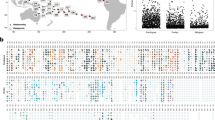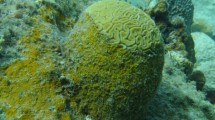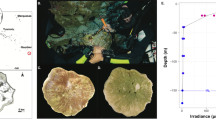Abstract
A lineage of plastid-bearing eukaryotic microbes that is closely related to apicomplexan parasites was recently found in a specific association with coral reefs (apicomplexan-related lineage-V, or ARL-V). Here, we address the possible nature of this association using plastid ‘contamination’ in fine-scale bacterial sequence surveys. In a transect between corals and associated macroalgae, ARL-V is specifically associated with the coral, in contrast to all microalgal types (including diatoms, haptophytes, pelagophytes and photosynthetic apicomplexan relatives, Chromera and Vitrella), which are associated with macroalgae. ARL-V is associated with at least 20 species of symbiotic corals through extended time periods and large geographic distances. It is significantly enriched in healthy coral tissue and shallow reef depths. Altogether, the evidence points to a specific relationship between ARL-V and corals, and is suggestive of symbiosis, perhaps based on photosynthesis.
Similar content being viewed by others
Main
Interactions between corals, symbiotic algae (Symbiodinium), bacteria and viruses, collectively known as the coral holobiont, have been studied extensively and are generally linked to the overall health of reef-building corals, disease and coral bleaching resulting from numerous stressors (Rosenberg et al., 2007). Among these interactions, those involving Symbiodinium have dominated our interpretations of holobiont ecology, with a few exceptions predominantly relating to declining health (for example, Upton and Peters, 1986; Toller et al., 2002; Dinsdale et al., 2008). In a recent large-scale phylogenetic analysis of bacterial environmental sequences, we showed that a significant number of ‘novel bacteria’ are actually eukaryotic plastids (chloroplasts) and that these plastids include several previously undescribed lineages, virtually all of which are related to apicomplexan parasites and exclusive to coral reef environments (Janouškovec et al., 2012). Two of the eight new apicomplexan-related lineages (named ARL-I to VIII) included known photosynthetic species (Chromera velia in ARL-III and Vitrella brassicaformis in ARL-I) that were described from coral surfaces and are generally considered to be symbionts (Moore et al., 2008; Oborník et al., 2012). However, the most abundant newly discovered plastid lineage, ARL-V, was not represented by any described species despite being globally distributed in coral reef habitats. ALR-V is completely absent from other ecosystems and phylogenetically distinct from Symbiodinium (Janouškovec et al., 2012), but its relationship with corals and role in reef environments are otherwise unknown. Here, we describe a series of meta-analyses drawing on numerous existing molecular surveys to address the possible interactions between the ARLs, corals, and the wider reef community.
The primary outstanding question regarding ARL-V is whether it is specifically associated with corals themselves, or more generally with reef environments. To address this, we re-analysed plastid sequence from a previous fine-scale 16S ribosomal RNA survey in Curacao that compared two key microbial habitats on the reef and their transition zone: coral surface and macroalgal surface (Barott et al., 2011, 2012). Four five-zone transects were sampled (each in five pooled replicates) spanning tissue and surface areas of the reef-building coral, Montastraea annularis (Zone 1), and one of the four reef-dominant macroalgae tightly associated with the coral (Zone 5), through their common interface (contact zone, Zone 3; see Supplementary Material and methods for details). Relative sequence occurrences for ARL-I, ARL-III, ARL-V and five microalgal groups (dinoflagellates were absent) were calculated for all zones (Supplementary Tables 1 and 2) and their median values across all transects were plotted for each zone to display the general trends in plastid abundance between corals and dominant reef macroalgae as a whole (Figure 1a). In general, plastid sequences were scarce or altogether absent in coral tissue and surface material, and significantly more abundant on the macroalgae associated with the coral. Interestingly, this distribution was true of all the common microalgal groups investigated (for example, diatoms, haptophytes and pelagophytes), but was also found for ARL-I and ARL-III (Vitrella and Chromera). This suggests, contrary to common belief, that Vitrella and Chromera may not be obligate coral symbionts, and possibly interact indirectly with coral. In contrast, ARL-V was confined to coral tissue and surface, and was completely absent from the macroalgae; a distribution entirely opposite to that of all representative algae (Figure 1a). A reference sample of Montastraea tissue/surface taken from a remote site on Curacao confirmed the Zone 1 pattern: ARL-V was the only plastid abundantly recovered (Supplementary Table 1).
The fine-scale distribution of ARL-V on coral surfaces (a), between coral species (b) and across depth gradients (c). (a) Relative occurrences of plastid sequences in a five-zone transect between Montastraea annularis and associated macroalgae. Colored lines connect median values from four transects in each zone (ARLs highlighted by thicker lines). Detailed zone descriptions are in the text. T/S=tissue/surface area (b) Relative occurrence of ARL-V among seven coral species and surrounding reef water. Species compared are Montastraea faveolata (Mfa), M. franksi (Mfr), Diploria strigosa (Dst), Acropora palmata (Apa), A. cervicornis (Ace), Porites asteroides (Pas), Gorgonia ventalina (Gve). Bars indicate proportion of ARL-V sequences (as %) compared with all other sequences characterized. Numbers next to bars indicate absolute sequence counts of V6-tags, or Sanger reads (in brackets if available). Colors and colored boxes on the left indicate three distinct coral groups (S=scleractinian robust and complex clade; O=gorgonian octocoral). (c) Depth distribution of ARL-V in Montastraea annularis from 5 m, 10 m and 20 m depths. Graphs show relative occurrence of ARL-V (as %) in clone libraries compared with all other sequences characterized. A similar pattern was observed in the terminal restriction fragment length polymorphisms analysis (Klaus et al., 2007).
The apparent association between ARL-V and Montastraea prompted us to ask whether this pattern is also found in other coral species. To test this, we expanded our search to ARL-V sequences from other coral reef surveys, altogether identifying 1124 ARL-V environmental sequences from 20 coral species (Supplementary Table 3). ARL-V was once again strictly associated with coral tissue and surface: in three studies that concurrently sampled corals and surrounding water (Reis et al., 2009; Sunagawa et al., 2010; Chen et al., 2011), we found no ARL-V sequences in reef water, but identified multiple in all corals sampled. Similarly, surveys of coral reef sediment that identified sequence from other plastids, including ARL-I (Vitrella), did not contain ARL-V (Sørensen et al., 2007; Garren et al., 2009; Gao et al., 2011). Lastly, in at least one coral species examined (Isopora palifera in Taiwan) we detected ARL-V’s sequence on 6 out of 7 occasions during 1 year (February and April to August; not detected in November; Chen et al., 2011), suggesting a prolonged association.
Interestingly, the 20 coral species associated with ARL-V do not form a monophyletic group, but comprise three distinct clades: scleractian ‘robust’ and ‘complex’ clades, and octocorals (Supplementary Table 3). To investigate whether ARL-V abundance varies among corals species, we identified all ARL-V sequences from a comparison of seven Caribbean coral species (Sunagawa et al., 2010) and found that ARL-V was ubiquitously present, but 1–2 orders of magnitude more abundant in the octocoral Gorgonia venteliana than in scleractinians (Figure 1b). This differential abundance was consistent in 454 and Sanger surveys, suggesting some host preference. Intriguingly, all ARL-V sequences are derived from coral species able to form a symbiotic relationship with Symbiodinium (Supplementary Table 3), but none was found in Symbiodinium-lacking coral microbiomes in public databases, or five studies we examined in detail. Ability to form algal symbiosis is widespread but species-specific among cnidarians, and may involve several types of algae (Venn et al., 2008), suggesting that repeated co-occurrence of ARL-V and symbiotic corals is significant.
These observations all lead to questions about the functional interactions between ARL-V and corals, the most obvious being whether ARL-V is a photosynthetic or non-photosynthetic, and mutualistic or parasitic. These hypotheses are difficult to distinguish without direct observations of ARL-V biology, however, two additional distribution patterns of ARL-V are noteworthy. Firstly, among several sequence surveys comparing healthy and diseased coral tissues (Barneah et al., 2007; Reis et al., 2009; Sunagawa et al., 2009), we recovered ARL-V almost exclusively from healthy tissue or surface, a pattern unexpected for a coral parasite (but also different from Symbiodinium; Correa et al., 2009). The relative ocurrence of ARL-V sequence in healthy, interface and black band disease-affected zones of Favites sp. from the Red Sea was 65% (20/31 total), 3% (1/35) and 0% (0/65) of the total sequence. We hypothesize that widespread and exclusive presence of ARL-V in healthy corals is more consistent with symbiosis based on mutualism, commensalism or opportunism rather than pathogenicity. Secondly, we found that distribution of ARL-V was strongly depth-dependent in sequence data previously generated from Montastraea annularis in the Caribbean (Klaus et al., 2007). We found ARL-V was consistently dominant in corals at 5 m depth (notably comprising more than a half of all sequences), less abundant at 10 m, and absent at 20 m depths (Figure 1c). While reasons for such a pronounced stratification within the photic zone remain unclear, we hypothesize it may be indicative of a photosynthetic lifestyle.
Altogether, a considerable body of evidence now points to the existence of a novel ARL that is exclusively associated with multiple species of corals through time and space. Whether ARL-V is an algal symbiont or a parasite remains unknown, but we hypothesize that it is photosynthetic based on its fine-scale distribution, suggesting it has simply been overlooked much as Chromera and Vitrella; testing this will require direct observation. In either event, the interactions between ARL-V and the coral holobiont are potentially highly significant to reef ecology, and demand further evidence. The next step should be to identify and describe this organism from its natural environment, and the environmental sequence distribution data provided here should focus this effort on the most abundant sources of ARL-V in nature.
References
Barneah O, Ben-Dov E, Kramarsky-Winter E, Kushmaro A . (2007). Characterization of black band disease in Red Sea stony corals. Environ Microbiol 9: 1995–2006.
Barott KL, Rodriguez-Brito B, Janouškovec J, Marhaver K, Smith JE, Keeling P et al (2011). Microbial diversity associated with four functional groups of benthic reef algae and the reef-building coral Montastraea annularis. Environ Microbiol 13: 1192–1204.
Barott KL, Rodriquez-Brito B, Youle M, Marhaver K, Vermeij M, Smith JE et al (2012). Microbial to reef scale interactions between the reef-building coral Montastraea annularis and benthic algae. Proc Royal Soc B 279: 1655–1664.
Chen C-P, Tseng C-H, Chen C a, Tang S-L . (2011). The dynamics of microbial partnerships in the coral Isopora palifera. The ISME Journal 5: 728–740.
Correa AMS, Brandt ME, Smith TB, Thornhill DJ, Baker AC . (2009). Symbiodinium associations with diseased and healthy scleractinian corals. Coral Reefs 28: 437–448.
Dinsdale EA, Pantos O, Smriga S, Edwards RA, Angly F, Wegley L et al (2008). Microbial ecology of four coral atolls in the Northern Line Islands. PloS One 3: e1584.
Gao Z, Wang X, Hannides AK, Sansone FJ, Wang G . (2011). Impact of redox-stratification on the diversity and distribution of bacterial communities in sandy reef sediments in a microcosm. Chinese J Oceanol Limnol 29: 1209–1223.
Garren M, Raymundo L, Guest J, Harvell CD, Azam F . (2009). Resilience of coral-associated bacterial communities exposed to fish farm effluent. PloS One 4: e7319.
Janouškovec J, Horák A, Barott KL, Rohwer FL, Keeling PJ . (2012). Global analysis of plastid diversity reveals apicomplexan-related lineages in coral reefs. Curr Biol 22: R518–R519.
Klaus JS, Janse I, Heikoop JM, Sanford RA, Fouke BW . (2007). Coral microbial communities, zooxanthellae and mucus along gradients of seawater depth and coastal pollution. Environ Microbiol 9: 1291–1305.
Moore RB, Oborník M, Janouškovec J, Chrudimský T, Vancová M, Green DH et al (2008). A photosynthetic alveolate closely related to apicomplexan parasites. Nature 451: 959–963.
Oborník M, Modrý D, Lukeš M, Cernotíková-Stříbrná E, Cihlář J, Tesařová M et al (2012). Morphology, ultrastructure and life cycle of Vitrella brassicaformis n. sp., n. gen., a novel chromerid from the Great Barrier Reef. Protist 163: 306–323.
Reis AMM, Araújo SD, Moura RL, Francini-Filho RB, Pappas G, Coelho AMA et al (2009). Bacterial diversity associated with the Brazilian endemic reef coral Mussismilia braziliensis. J Appl Microbiol 106: 1378–1387.
Rosenberg E, Koren O, Reshef L, Efrony R, Zilber-Rosenberg I . (2007). The role of microorganisms in coral health, disease and evolution. Nature reviews. Microbiology 5: 355–362.
Sørensen K, Glazer B, Hannides A, Gaidos E . (2007). Spatial structure of the microbial community in sandy carbonate sediment. Mar Ecol Prog Ser 346: 61–74.
Sunagawa S, DeSantis TZ, Piceno YM, Brodie EL, DeSalvo MK, Voolstra CR et al (2009). Bacterial diversity and White Plague Disease-associated community changes in the Caribbean coral Montastraea faveolata. The ISME Journal 3: 512–521.
Sunagawa S, Woodley CM, Medina M . (2010). Threatened corals provide underexplored microbial habitats. PloS ONE 5: e9554.
Toller W, Rowan R, Knowlton N . (2002). Genetic evidence for a protozoan (phylum Apicomplexa) associated with corals of the Montastraea annularis species complex. Coral Reefs 21: 143–146.
Upton S, Peters E . (1986). A new and unusual species of coccidium (Apicomplexa: Agamococcidiorida) from Caribbean scleractinian corals. J Invertebr Pathol 47: 184–193.
Venn AA, Loram JE, Douglas AE . (2008). Photosynthetic symbioses in animals. J Exp Bot 59: 1069–1080.
Author information
Authors and Affiliations
Corresponding author
Additional information
Supplementary Information accompanies the paper on The ISME Journal website
Supplementary information
Rights and permissions
About this article
Cite this article
Janouškovec, J., Horák, A., Barott, K. et al. Environmental distribution of coral-associated relatives of apicomplexan parasites. ISME J 7, 444–447 (2013). https://doi.org/10.1038/ismej.2012.129
Received:
Revised:
Accepted:
Published:
Issue Date:
DOI: https://doi.org/10.1038/ismej.2012.129
Keywords
This article is cited by
-
Beyond the Symbiodiniaceae: diversity and role of microeukaryotic coral symbionts
Coral Reefs (2023)
-
A widespread coral-infecting apicomplexan with chlorophyll biosynthesis genes
Nature (2019)
-
Isolation of plastids and mitochondria from Chromera velia
Planta (2019)
-
The effect of light quality and quantity on carbon allocation in Chromera velia
Folia Microbiologica (2019)
-
Deciphering the nature of the coral–Chromera association
The ISME Journal (2018)




